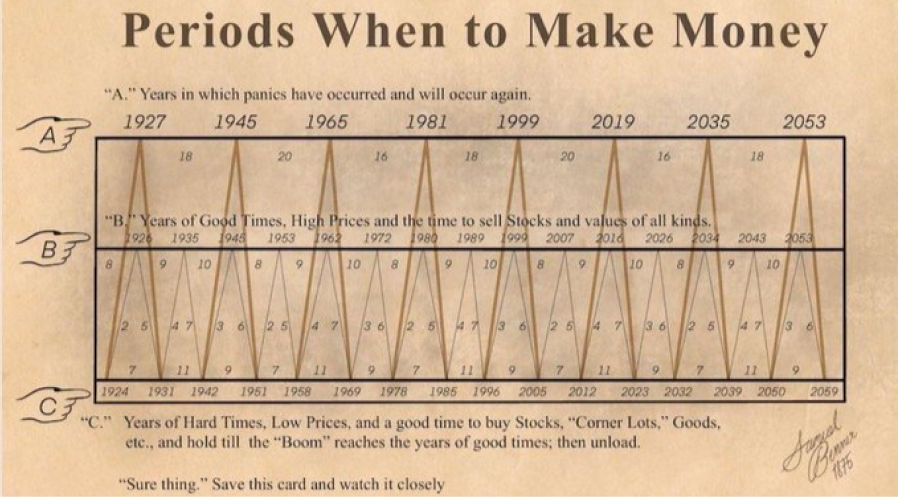Evgen verzun
Blog
November 11, 2024
Periods When to Make Money: Fact-Checking Samuel Benner’s Timeless Market Cycle Theory

Imagine losing everything you own in a devastating economic downturn. Most people would feel defeated, but Ohio farmer Samuel Benner decided to do something about it. Instead of trying to rebuild his farm the old-fashioned way, Benner became obsessed with understanding the market itself, meticulously analyzing historical data to uncover patterns. His tools? Pen, paper, and a strange mix of pig prices, iron, and grain data.
Benner’s Big Insight: Market Cycles
Benner envisioned the market as a kind of rhythm or pulse, a predictable dance of peaks, troughs, and plateaus. Here’s the gist of his discovery:
- Peaks – Times to sell high
- Troughs – Opportunities to buy low
- Plateaus – Moments to HODL (hold on for dear life)
He noticed these patterns followed a certain timeline, with boom cycles every 8-9 years, major busts every 16-18 years, and more stable periods in between. This idea was groundbreaking, as it suggested that markets weren’t entirely chaotic but moved in cycles that could, in theory, be predicted.
Fast Forward: Does Benner’s Cycle Still Hold True?
Fast forward to today. Benner’s theories have attracted financial enthusiasts who have tested his predictions against modern markets, particularly the S&P 500. Believe it or not, Benner’s cycle lines up surprisingly well with several major market events:
- The Great Depression in the 1930s,
- The dot-com bubble burst in the early 2000s,
- And the 2008 financial crisis.
While the fit isn’t perfect—markets are far from flawless machines—the general trend in Benner’s cycles does align closely with significant financial downturns and recoveries.
Fact Check: Does Cycle Really Work?
Before we dive deeper, let’s clear one thing up. I checked the facts, and Benner’s predictions aren’t just folk wisdom; they hold some weight.

By analyzing cycles in the S&P 500, modern analysts have found similar rhythms, especially around pivotal economic events. Although Benner’s cycle isn’t a foolproof market timer, it’s grounded in observable, real patterns. His insights are more than just a lucky guess—they’re a framework for spotting potential turning points in the market.
Why Benner’s Cycle Matters for Today’s Investors
Benner’s observations provide two major lessons for investors, especially beginners:
- History Repeats Itself (Well, Sorta) Markets, like fashion, tend to cycle. Understanding these patterns can help you anticipate market shifts. Benner’s insights suggest that if you can identify a peak or trough, you can make strategic decisions to maximize gains or minimize losses.
- The Past is a Powerful Teacher Benner’s model isn’t a crystal ball, but studying historical trends can offer valuable clues about what might lie ahead. Knowing that downturns and recoveries occur in cycles, investors can approach the market with a level-headed, long-term view.
Final Thoughts: Timing the Market Like Benner
Samuel Benner’s market cycle theory, dating back to the 1870s, still resonates today. It’s a reminder that while no one can predict every market fluctuation, there are patterns that emerge over time. For beginner investors, Benner’s insights offer a perspective that turns market chaos into something more structured—a dance between boom and bust that has, more often than not, followed a similar beat. Understanding these cycles won’t make you a fortune overnight, but it may just give you an edge in navigating the unpredictable world of investing.